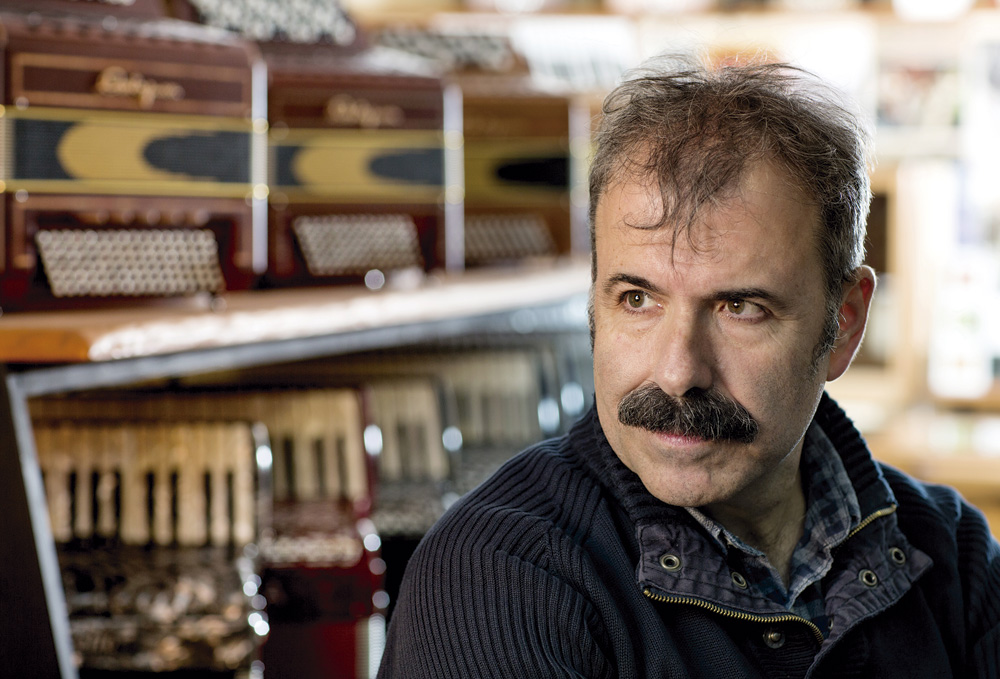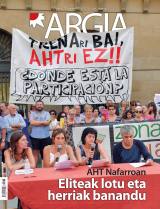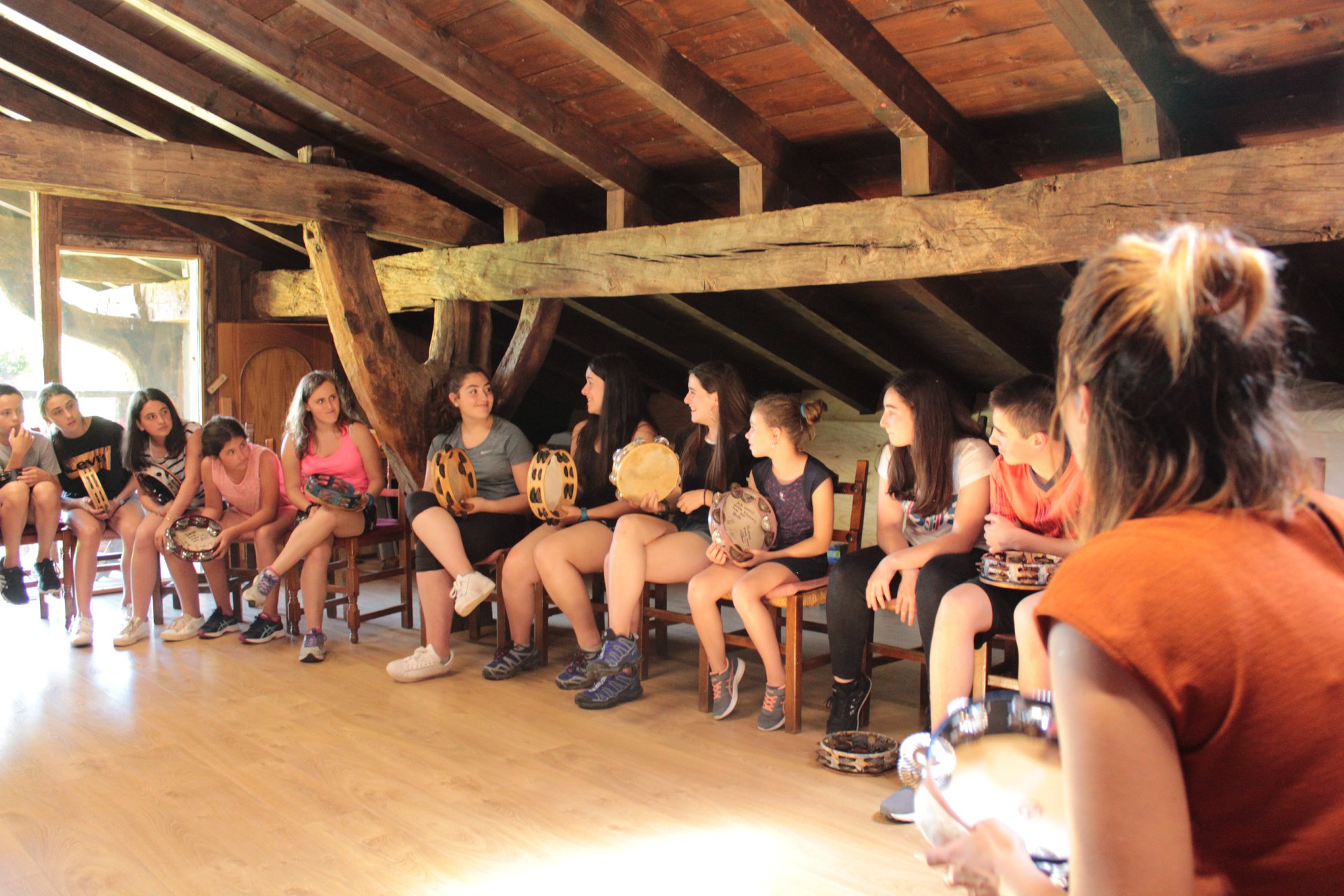"Many of the instruments we have for cults are seen elsewhere as grass."
- The great Joseba Tapia, the nephew of the great Eleuterio Tapia, was born the year in which the great Elgeta of Durango died. All great, playing very well, claiming the greatness of small sound over here and around the world, both on the new album of Besamotzak and in the book Larreko eskolatik.

Trikitilaria, trikitilaria baino gehiago aspaldi. Musikaria. Sortzailea. Artista. Etxekoen jarraitzaile zintzo eta leial eta, aldi berean, haiekin hautsi zuena. Espektakulu hutsa. Bizi osoa musika sortzen, kasik 40 urte diskoak argitaratzen, formula zaharrak eta bide berriak saiatzen beti. Joseba Tapia, erraldoia.
You bring a new album, but I'm interested in your reflection so much or more: From Larrea School, notes to enjoy the trikitixa (Tirikitauki, 2016).
When I was seven years old, I got a fandango, and then they thought at home. “This is a musician”, because in the family – among other uncles – they were trikitilaris. Those trikitilaris were not considered musicians, nor was their small sound a serious instrument. Probably, because the chromatic sounds laughed at them, on the one hand, and on the other hand, it played chromatic sounds because the pieces couldn't touch themselves. They marveled when they heard the chromatic sound. That's why, on their advice, I got into the Bikondoa Accordion School.
Great sound, I mean.
Yeah, great sound. He was the master of all parties, weddings and others. The small sound was an instrument that touched in the hermitage environment and in remote places some peasants. It was a chromatic sound! Our trikitilaris guys marveled at the great sound. Eleuterium [Tapia] took me to Larraitz [Ñañarri in the shadow] to the headdress meetings. There were Juanito Kaolin, Elola... and the chromatic sounds of yesteryear. And we along with them. That was great. However, I had already left a great sound. When I went to the trikitixa, I knew the wonder of the great sound.
You spoke very little.
I was amazed at the sound. The family played the trikitixa and I want it. There, however, something else happened… I, they took me to study a lot of sound to Bikondoa, and the Bikondoa was not fond of popular chromatic sound. What's more, I hated her as I hated the little noise. Miguel Bikondoa had a father in the popular chromatic accordion, Diego Bikondoa. I met a man with a hat on his head and a big noise on his back. Very fun. Her son, instead, was more elitist. Chromatic sound led to environmental culture, classical culture, and later contemporary music. It made us touch pieces by Russian authors.
No triki.
At first, Miguel might teach us a fandango, but soon they were all out. Soon we began to prepare for concerts and to learn difficult works. At the age of 14, they made my parents buy a bigger sound. It weighed fourteen kilos, it was a great Hohner, the basses on the left with the system Basetti.Creo which was then when I said to myself, “I don’t want to go on this.”
14 years for you.
I guess age would have taken me too. I was studying the work La Campanella, I remember, and how much time I needed to learn a page! That, to me, has been a sad aspect of music. On the contrary, the popular – also chromatic – sound of my uncles was joyful. I tended to do it.
Was little sound not taught in schools?
No, there were no teachers. Everyone was learning on their own. He was our uncle one of the first to show it. Later began Martin, Laja and others. There was no school to teach. I think he taught Sakabi, and before Elgeta, of course. For the rest, I would say that for a while there were no young trikitilaris. I mean, I was 14 years old, all the Trikitilaris back then were pretty old. The middle generation was missing. There was one, however, with Sahatseta and another.
You mean the trikitixa was going to be lost?
At least, down. Then, in the 1970s, ikastolas flourished, democracies flourished and those that are and are not, and a small sound was introduced into that world and society of the Basque Country as if it were autochthonous. It's not a whistle, it's not a big noise. By then, both the Txistu and the great sound had already taken the path of global culture. On the other hand, the appearance of the new generation with a small sound was what happened: Kepa Junkera, Imuntzo, ourselves -- that generation was renewing the sound.
This generation had the opportunity to see the championship with a window and a plaza.
After the war, the championships began in 1970. The Plaza de la Trinidad de San Sebastian was filled. I remember that in 1979, when I had not yet started with the trikitixa, the fronton of Anoeta had also been filled. The small sound was popular, it had strength, but it still happened in a very provincial province. At that time, parents started sending their children to study the trikitixa. And trikitixa schools emerged. One of the most important was Martin's.
And the way to prove it?
This also changed. Eleuterium taught us from ears, Martin used numbers, he put numbers on the sound buttons. From Martin's school came the most famous trikitilaris from here: Gozategi, Maixa eta Ixiar, Alaitz eta Maider, Iparragirre, Iker Goenaga, Azkonobieta, Laura Apeztegia… a generation.
The trikitixa also entered music schools.
And I was a professor at the Hernani Conservatory. For example, Juan Mari Beltrán taught unusual instruments in a txalaparta, alboka and a conservatory. Larrea's trikitixa entered. However, and this is the burrow of my theory, all the grazing music instruments that had to be folded to the philosophy of the Conservatory.
What do you mean?
That the conservatories had not approached the grass instruments, that the pastors had had to approach the conservatory cage. The weight of teaching was imposed, full of standards of teaching and sadness. All the trikitixa students were forced to learn solfeo, to play classical works together since childhood, but these works did not enter the tone of the small sound.

How many years?
Today, children start music school at the age of 7-8. We started in adolescence. And what does a music student do from age 7 to adolescence? Harto. Because at the School of Music, they impose that teaching weight on them. It is not the school that we would place in the leisure, it is another race, with all its strict duties. There are people who do very well, but after turning 16 they do not touch the instrument that touched them day and night again.
You would place the trikitixa in your spare time, you would like to graze.
I'm not creating a new pedagogy, I mean what I've known in my own skin and what I've seen walking around the world. In all the world's folk festivals, you play grass music, not cultured music, but many of the instruments that we have for cults look there as grass. For example, the violin, something that we worship, is grass at the festivals of one side or another. Because the tool is not a problem, but a record that each one brings. We've also known the chromatic accordion, a black man from Louisiana, playing piano, playing three simple things, but how to play it! His taste, his rhythm -- he wasn't learned, he talked about hearing.
The chromatic sound and small sound have been repaired, as you said.
When you touch a big sound and the other a small sound, you'll try to touch it in every tone, to show the little one that doesn't reach its level. On the contrary, the meadow doesn't come to step on anyone, it comes to meet. Worship doesn't, worship has to score its range. I have also seen this in Uzbekistan, the ambition of the great sound in the face of the small sound: to tread. But I say that the problem is not the instrument, but the interpreters. They prepare for the orchestra, for them the important thing is to read the score on the first visit, the first is precision. We, on the other hand, work in another work, there is no conflict between the field and the cult, but we are working on different paths. It seems to me to be a builder in the face of our musical teaching.
Many will say it's a music.
Yes, but we're not at the same job. I can't think about playing in the orchestra, working in the field that I do. Even the one in the orchestra will hardly be able to play by ear with anyone, because they have never put themselves to it. There's no communication.
The ear is the side.
The Orchestra musician stands out for his absolute hearing. Touch a note of this kind and identify the sustained sun as quickly as possible. That is no use to us. Our ear is to be able to hear a melody and play it. I don't need any role to play the music I've heard, the orchestra does. My attitude is an attitude, and they do not accept any provision, they have to go precisely. In our case, the course is applauded, in which we have to interpret precisely what the score promises, there is no possibility of contributing. In the Basque Country, however, everything is a contribution. The maternal heritage of Larrea's music? The correlation of simple harmony, which we do not need to think about, that everyone can follow.
Play on the one hand, play on the other.
I started playing chromatic sound at the age of 7, and now, big sound teachers have no choice but to teach the trikitixa, the instrument they hate.
Will the trikitixa also reach that point?
I'm afraid, because trikitixa always has to do with the pasacalles, the pilgrimage, the festival and something. However, it would not be surprising if the student lost the desire to learn trikitixa if he demonstrated it in such a narrow way. On the other hand, the trikitilaris have left us unprotected. We've opened up to all the music in the world, and we have to compete against all the big companies and companies in the world, which is impossible. Our media is run by large corporations and we cannot approach our young people, who consume music from large multinationals, not ours. If we consume our music, they should be aware, be critical, and this and that. The Trikitilaris are dead, we cannot compete, nor does the Basque world protect us.
The Basque either?
No, Bertsolarism, for example, is “Euskara.” We are not, we are “culture”. The Basque Country does not take us into account either. Our destruction is obvious. The song in Basque is totally unprotected. When did you hear the last song in Basque? Where?... Trikitixa has made a hole when it has approached other music such as trikipoteo, trikifolk, trikirock, etc. In these cases, the approach of the trikitixa to these music has been celebrated, but critics have applauded the approach, for example, not to the trikitixa itself. We let the trikitixa die on the corner. Today, only the trikitixa that moves in that consumption environment is supported.
Nothing else?
A closed world, if you will. De laja, Izer and many others, romerías de Iturriotz, Attola and other places… Those are not within the world of consumption, of course, but, at least, they have a little support, that of that old world of tradition. That music is consumed there. We don't have that protection either, our music isn't consumed. We are for solidarity campaigns.
So what is the future you want to the small sound?
I am fascinated by all instruments, not just by sound. The question is what is done with the instruments. That's the bad thing. The question is what will happen to the Basque Country, what will happen to the culture that is created here… I am not too optimistic, but it will, on the left or on the right, but it will. There will be music. For the rest, I am not concerned. We also participated in the disappearance of the previous music. There was a time when they had certain needs and the trikitixa made its place. Anyway, I don't feel debt to the instrument, but I do debt to the music. And with regard to music, not in a neutral way, but with respect and seriousness.
What do you mean?
For example, when I met Apalatxeta's music, I understand its context, style and lifestyle. We might think that's going to change, and I'm not worried. I am concerned about the ecology of music, we have to guarantee the production and the life with which they produce it. Furthermore, is this not the only way to reverse all crises? There produce music and art based on your needs. It's ecology, no snobbery. Doesn't it give this world color, diversity and wealth? That is the solution to our problems. And globalisation should also be that way, guaranteeing everyone’s work, on the basis of quality. That is obvious!
“Bikondoak nire gurasoei esaten ziena: ‘Lastima, mutil honek belarri ona dauka. Etzaiozue utzi belarriz jotzen. Jo dezala paperetik.’ Orkestrarako nahi gintuen, artaldean, zuzendariaren mendean. Guk, berriz, besterik nahi genuen, libre”
“Guraso batek esan zidan. Bera musikaria, alaba biolina jotzen abila. ‘Zein ondo jotzen zuen gure alabak biolina. 16 urte bete ditik, gainditu dik kurtsoa, eta uztera zoak biolina!’. Esan nion: ‘Pozik egon! Agindutakoa bete dik, ez? Aprobatu dik. Hik, berriz, frustrazioa adierazten duk’. Jakina, hori oso urrun dago alaitasunetik”
“Euskadi Gaztea sortu zenean elkarrizketa egin zion Ramon Sanchezek, esango nuke, Edurne Ormazabali. Galdera Ramonek: ‘Musikaren irrati berri honetan, trikitirik egongo al da?’. Eta erantzuna: ‘Rock baldin bada, bai’. Oso argigarria. Eta horrelaxe gertatu da.”

















